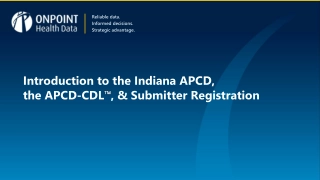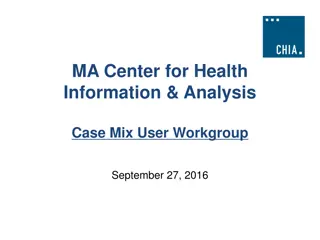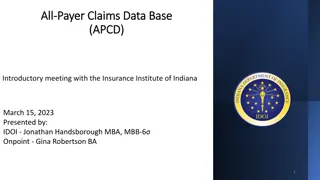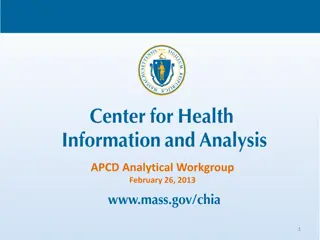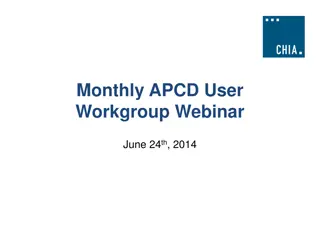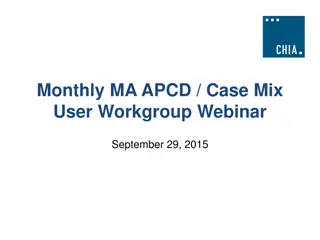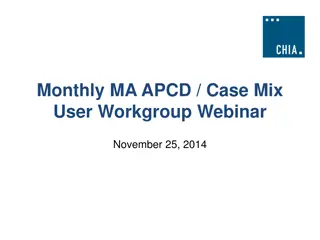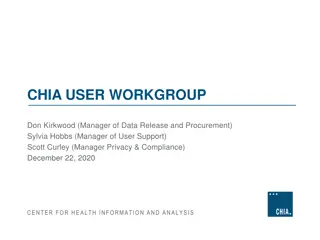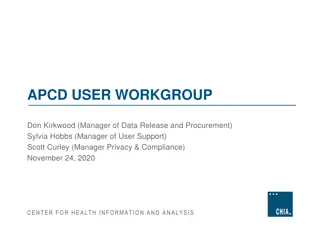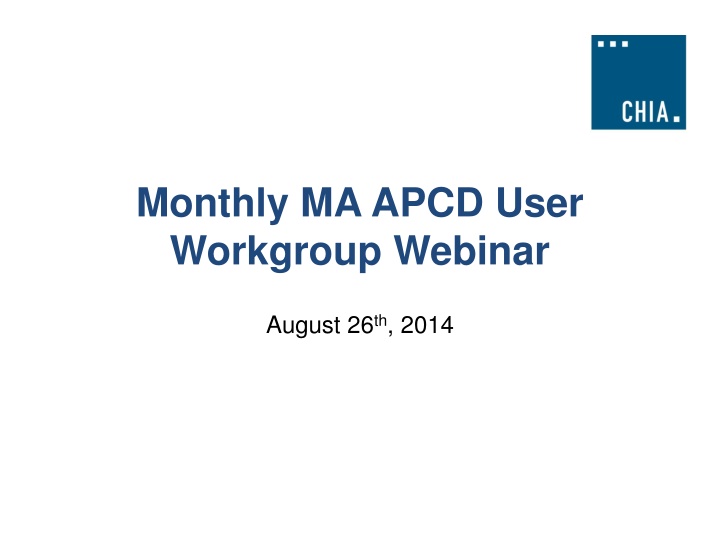
August 26th, 2014 MA APCD User Workgroup Webinar Insights
Explore insights from the August 26th, 2014 MA APCD User Workgroup Webinar, including common application issues, tutorial details, and announcements regarding de-identified data. Get answers to questions raised by APCD users and understand the importance of specifying data years and security measures in applications.
Download Presentation

Please find below an Image/Link to download the presentation.
The content on the website is provided AS IS for your information and personal use only. It may not be sold, licensed, or shared on other websites without obtaining consent from the author. If you encounter any issues during the download, it is possible that the publisher has removed the file from their server.
You are allowed to download the files provided on this website for personal or commercial use, subject to the condition that they are used lawfully. All files are the property of their respective owners.
The content on the website is provided AS IS for your information and personal use only. It may not be sold, licensed, or shared on other websites without obtaining consent from the author.
E N D
Presentation Transcript
Monthly MA APCD User Workgroup Webinar August 26th, 2014
Agenda I. II. Common Application Issues / Questions III. Questions from Current APCD Users IV. Tutorial on how to count patients admitted through the ED in Case Mix data V. Tutorial on how to identify managed care patients in the MA APCD Announcements
Announcements Case Mix Level 1 is now fully de-identified Still not a public dataset, however You must still apply for the data the same way you would apply for any other Case Mix data
Common Application Issues #1 Failure to specify which years of data are requested
Common Application Issues #2 - Data security questions left BLANK
Common Application Issues #3 Missing application materials Required prior to REVIEW: Data Request Application Data Specification Worksheet Research Methodology Application Fee / Request for Fee Waiver Documentation of IRB Approval (if necessary) Required prior to FULFILLMENT: Data Use Agreement Confidentiality Agreements for All Members of the Project Team Research Methodology Medicaid Acknowledgement of Conditions (if applicable) Fee Waiver Request Required prior to DELIVERY OF DATA: Data Fees [unless you applied for and were granted a fee waiver by CHIA]
Questions from MA APCD Users QUESTION #1 The Member Deductible (ME049), Medical Deductible (ME111), Pharmacy Deductible (ME112), and Behavioral Health Deductible (ME114) seem to be categorical variables. For instance for Member Deductible, values range from 0- 60, with smaller step-wise increments in the lower values (0,1, 1.5, 2, 2.4, 4, 3.5, 4, 5, 6, 7 .40, 50, 60 etc). This does not match what is specified in the submission guidelines.
Questions from MA APCD Users QUESTION #1 - Answer For currency fields, CHIA imputes a decimal. Note that '0' is a value (not null).
Questions from MA APCD Users QUESTION #2 Around 54% of members in the claims sample (when de- duplicated by payer specific member code) have no value in the Member Deductible (ME049) variable. Do you have any thoughts on why these values might be missing for those members?
Questions from MA APCD Users QUESTION #2 - Answer A-level fields can have a value of '0'. Please note that member deductible (ME049) is not the same as medical deductible (ME111), as described in the Submission Guide. Note that about 90% of ME049 values are expected to be valid and that carriers may request a variance for a threshold lower than 90%.
Questions from MA APCD Users QUESTION #3 The Product File Layout makes references to a Lookup Table similar to the other files (Medical Claims, Dental Claims, etc), but there does not seem to be an appended lookup table in this file s documentation. Could you point us to the correct document to find the file element Lookup Table for the Product File? We do see similar information in the Product File submission guide can we assume those definitions are the same as what would be found in the Lookup Table?
Questions from MA APCD Users QUESTION #3 - Answer Tables are embedded in the Submission Guide. Please note that tables will be added to the Release 3.0 Documentation Guide.
Questions from MA APCD Users QUESTION #4 What is a Coordinated Care model (PR014) for APCD purposes? Does this include HMOs? Currently appears that 75% of patients are in a coordinated care model. The submission guide states that 1 means Member's care is clinically coordinated/managed, but we were wondering if you have further insight into how the payer determines or tracks this field.
Questions from MA APCD Users QUESTION #4 - Answer With the 649,759 Products that have Code 1 (Yes) for the Coordinated Care Model, 88.98% of those products are attributable to HMOs. For Release 2.1, this is a C-level field. Payers provide information on their website about their Coordinated Care Models. In addition, payers are indicating on their websites their support of GIC s Centered Care Initiative. For more information on this initiative and how it relates to coordinated care, see GIC website.
Questions from MA APCD Users QUESTION #5 What is a Health Care Home (ME035-39) for APCD purposes? Currently 7% of patients are reported as in one. The list of named Health Care Homes includes large hospitals and individual providers. The submission guide defines these as patient centered medical home, so does that mean that these patients were assigned to a recognized PCMH as of the date of submission?
Questions from MA APCD Users QUESTION #5 - Answer Approved PCMH is determined by each carrier using their own criteria. For B- and C-level fields, intake edits are applied but a file does not fail (as noted in the Documentation).
TUTORIAL How to Count Patients Admitted from the Emergency Department (ED) in the Casemix Hospital Discharge Data (HDD)
How Do I Count Patients Admitted from the Emergency Department (ED) in the Casemix Hospital Discharge Data (HDD)? Emergency Department Patient Inpatient Admissions Trajectory Dead on Arrival, Routine Department, Left Against Medical Advice, Transferred, Expired in ED Patient Seen in Observation Stay Patient Admitted to Hospital Patient Arrives at Outpatient ED Patient Admitted to Hospital Observation Stay Routine Departure, Left Against Medical Advice, Transferred, Expired in Observation Stay Patient Admitted to Hospital Patient is a direct Outpatient Observation Stay Inpatient Admission Routine Discharge, Left Against Medical Advice, Discharged/Transferred to another facility, Expired while inpatient Patient is a direct Inpatient Admission
How to Count Patients Admitted from the Emergency Department (ED) in the Casemix Hospital Discharge Data (HDD) Patients admitted directly from the ED do not have a record in the ED Visit data. Services associated with their ED visit are rolled into their inpatient hospital discharge data (HDD). If you need to include these patients in an ED volume count or determine what proportion of ED patients contribute to inpatient discharge volume, here are the methods you can use. ED Flag Code HDD contains an ED Flag Code with the following coding options: METHOD Filter by ED Flag Code 2 ED Flag Code Admitted ED Patient Status Definition Filter HDD by ED Flag Code 2to count inpatient discharges admitted from the ED 0 Not admitted from the ED, no ED visit reflected in this record 1* Not admitted from the ED, but ED visit(s) reflected in this record 2 Admitted from the ED Approximately 90% of hospitals submit enough data ED Flag Code data to determine the number of patients admitted through the ED. Other field can be used to determine admissions through ED for the other 10%. * Note: Code 1 is for patients not admitted as an inpatient directly from the ED, but a recent ED visit is included in this record because of payment window rules.
How Do I Count Patients Admitted from the Emergency Department (ED) in the Casemix Hospital Discharge Data (HDD)? (continued) Source of Admission While 90% of hospitals consistently use the ED Flag Code to indicate admissions through ED, for the 10% that do not, primary and secondary source of admission codes can be used. HDD contains Source of Admission Code with the following coding options: METHOD Filter by Code R 0 = Information N/A 9 = Other (to include level 4 Nursing Facility) 1 = Direct Physician Referral L = Outside Hospital Clinic Referral Filter HDD by Primary or Secondary Source of Admission Code R to count Inpatient discharges admitted from the ED 2 = Within Hospital Clinic Referral M = Walk-In/Self Referral R = Within Hospital ED Transfer T = Transfer from Another Institution s Ambulatory Surgery 3 = Direct Health Plan or HMO Referral 4 = Transfer from an Acute Hospital 5 = Transfer from a SNF W = Extramural Birth 6 = Transfer from Intermediate Care X = Observation 7 = Outside Hospital ED Transfer Y = Within Hospital Ambulatory Surgery Transfer 8 = Court/Law Enforcement
How Do I Count Patients Admitted from the Emergency Department (ED) in the Casemix Hospital Discharge Data (HDD)? (concluded) Revenue Codes Outpatient ED services provided to those admitted to inpatient status appear in the inpatient HDD Revenue Codes. HDD contains Revenue Codes with the following coding options for ED use: METHOD Filter by Revenue Codes 0450 = Emergency Room 0451 = Emergency Room: EM/EMTALA 0452 = Emergency Room: ER/ Beyond EMTALA 0456 = Emergency Room: Urgent care 0459 = Emergency Room: Other emergency room 0981 = Professional fees : Emergency room Filter HDD by Revenue Codes associated with ED use The most commonly used revenue code for emergency department services is Revenue Code 0450. In the past 2 years, a few began using codes 0459 and 0981.
TUTORIAL What APCD Fields Can be Used to Filter for Medicaid Managed Care Beneficiaries?
In Currently Released Data, Two APCD Fields in the Product File and Eligibility File Can be Used to Filter for Medicaid Managed Care Beneficiaries Member Eligibility ME003 Insurance Type /Product Product File PR004 Product Line of Business Code Product Line Of Business Model Code 12 13 14 15 16 Insurance Type Preferred Provider Organization (PPO) Point of Service (POS) Exclusive Provider Organization (EPO) Indemnity Insurance Health Maintenance Organization (HMO) Medicare Advantage 12 13 14 15 16 Preferred Provider Organization (PPO) Point of Service (POS) Exclusive Provider Organization (EPO) Indemnity Insurance Health Maintenance Organization (HMO) Medicare Advantage AC BH CH DM DS HC HO IN LM MC MO MP MR OF PC PR QM SA SC SP TV VA WC ZZ Accident Only Basic Hospital CHAMPUS Dental Maintenance Organization Disability HMO - Closed HMO - Open Individual Liability Medical Medicaid FFS Medicaid Managed Care Organization Medicare Primary Medicare Other Federal Program (e.g. Black Lung) Medicaid Primary Care Clinician Plan Preferred Provider Organization (PPO) Qualified Medicare Beneficiary/SLMB Self Administered Group Senior Care Option Supplemental Policy Title V Veterans Administration Plan Workers' Compensation Mutually Defined Other 17 AM DS HM HN LI LM MA MB MC MD MO MP OF QM SC SP TV VA WC Dental Maintenance Organization (DMO) Automobile Medical Disability Health Maintenance Organization HMO Medicare Risk/Medicare Part C Liability Liability Medical Medicare Part A Medicare Part B Medicaid Medicare Part D Medicaid Managed Care Organization Medicare Primary Other Federal Program (e.g. Black Lung) Qualified Medicare Beneficiary Senior Care Option Supplemental Policy Title V Veterans Administration Plan Workers' Compensation
In the June 2013 APCD Specifications, a new Medical Claims Field was incorporated to designate Medicaid Managed Care Beneficiaries In addition to Product File PR004 Product Line of Business and Member Eligibility ME003 Insurance Type /Product, in June 2013 filing specifications a new data element to designate New Field MC241 Member Enrollment Type Value Description 1 FIG - Fully-Insured Commercial Group Enrollee 2 SIG - Self-Insured Group Enrollee 3 GIC - Group Insurance Commission Enrollee 4 MCO - MassHealth Managed Care Organization Enrollee 5 Supplemental Policy Enrollee 6 ICO - Integrated Care Organization 0 Unknown / Not Applicable **Will be available with Release 3.0**
Questions? General questions about the APCD: (CHIA-APCD@state.ma.us) Questions related to APCD applications: (apcd.data@state.ma.us) Questions related to Casemix: (casemix.data@state.ma.us)
Upcoming Workgroup Topics CHIA will be publishing data profiles in the coming months Frequencies on common fields for the top 7 payers Lessons learned from CHIA s analysis of the Member Eligibility file Additional Suggestions?
Poll Are you interested in seeing more information / tutorials during these webinars on Case Mix data?

